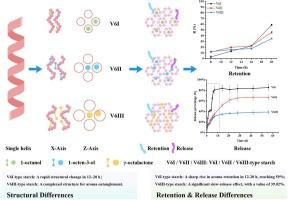淀粉以v6型晶体形式保留和缓释香气分子的结构机理研究
IF 12.5
1区 化学
Q1 CHEMISTRY, APPLIED
引用次数: 0
摘要
从微观层面——单螺旋结构、单细胞结构、片层结构,到宏观层面——结晶结构和晶体性质,分析了v6型淀粉的结构演变过程。确定了v型淀粉结构影响香气保留的机理。分别以1-辛醇、1-辛烯-3-醇、γ-辛内酯为原料制备了结构特征不同的V6I-型、V6II-型和v6iii型6型淀粉。v6i型淀粉单螺旋含量较高,单细胞和片层结构具有较大的结构变异性,在12-20 h时香气保留率显著提高,保留率较高(R = 59%)。相比之下,V6II型和v6iii型淀粉具有较低的结构变异性和较低的v型晶体密度,具有较高的初始保留率(t≤12 h),但最终保留率较低,分别为46%和35%。相关分析表明,微观结构对宏观晶体结构具有累积效应,香气保留率与晶体结构(相对结晶度)、晶体性能(短程有序度和结构稳定性)的正相关最高。v6iii型淀粉缓释效果最好,为39.02%。这些发现阐明了结构驱动的策略来调整v6型淀粉的香气保留和释放。本文章由计算机程序翻译,如有差异,请以英文原文为准。

Structural mechanism study on the retention and slow release of aroma molecules by starch in the form of V6-type crystals
The structural evolution of V6-type starches was analyzed from the microscopic level—single-helix conformation, unit cell structure, and lamellar structure—to the macroscopic level—crystalline structure and crystal properties. It also identified the mechanisms by which the structure of V-type starch affected aroma retention. Three V6-type starches, i.e. V6I-, V6II-, and V6III-type, with different structural characteristics, were prepared using 1-octanol, 1-octen-3-ol, and γ-octalactone, respectively. V6I-type starch, with its higher content of single helices and greater structural variability in both unit cell and lamellar structures, showed a significant increase in aroma retention at 12–20 h, resulting in a high retention rate (R = 59 %). In contrast, V6II- and V6III-type starches, with lower structural variability and less dense V-type crystals, exhibited higher initial retention rates (t ≤ 12 h) but lower final retention rates of 46 % and 35 %, respectively. Correlation analysis indicated that the microstructure had a cumulative effect on the macroscopic crystalline structure, with the highest positive correlation between aroma retention rate and crystalline structure (relative crystallinity) as well as crystal performance (short-range order and structural stability). V6III-type starch showed the best slow-release effect, with a value of 39.02 %. These findings illuminate structure-driven strategies for tailoring aroma retention and release in V6-type starch.
求助全文
通过发布文献求助,成功后即可免费获取论文全文。
去求助
来源期刊

Carbohydrate Polymers
化学-高分子科学
CiteScore
22.40
自引率
8.00%
发文量
1286
审稿时长
47 days
期刊介绍:
Carbohydrate Polymers stands as a prominent journal in the glycoscience field, dedicated to exploring and harnessing the potential of polysaccharides with applications spanning bioenergy, bioplastics, biomaterials, biorefining, chemistry, drug delivery, food, health, nanotechnology, packaging, paper, pharmaceuticals, medicine, oil recovery, textiles, tissue engineering, wood, and various aspects of glycoscience.
The journal emphasizes the central role of well-characterized carbohydrate polymers, highlighting their significance as the primary focus rather than a peripheral topic. Each paper must prominently feature at least one named carbohydrate polymer, evident in both citation and title, with a commitment to innovative research that advances scientific knowledge.
 求助内容:
求助内容: 应助结果提醒方式:
应助结果提醒方式:


